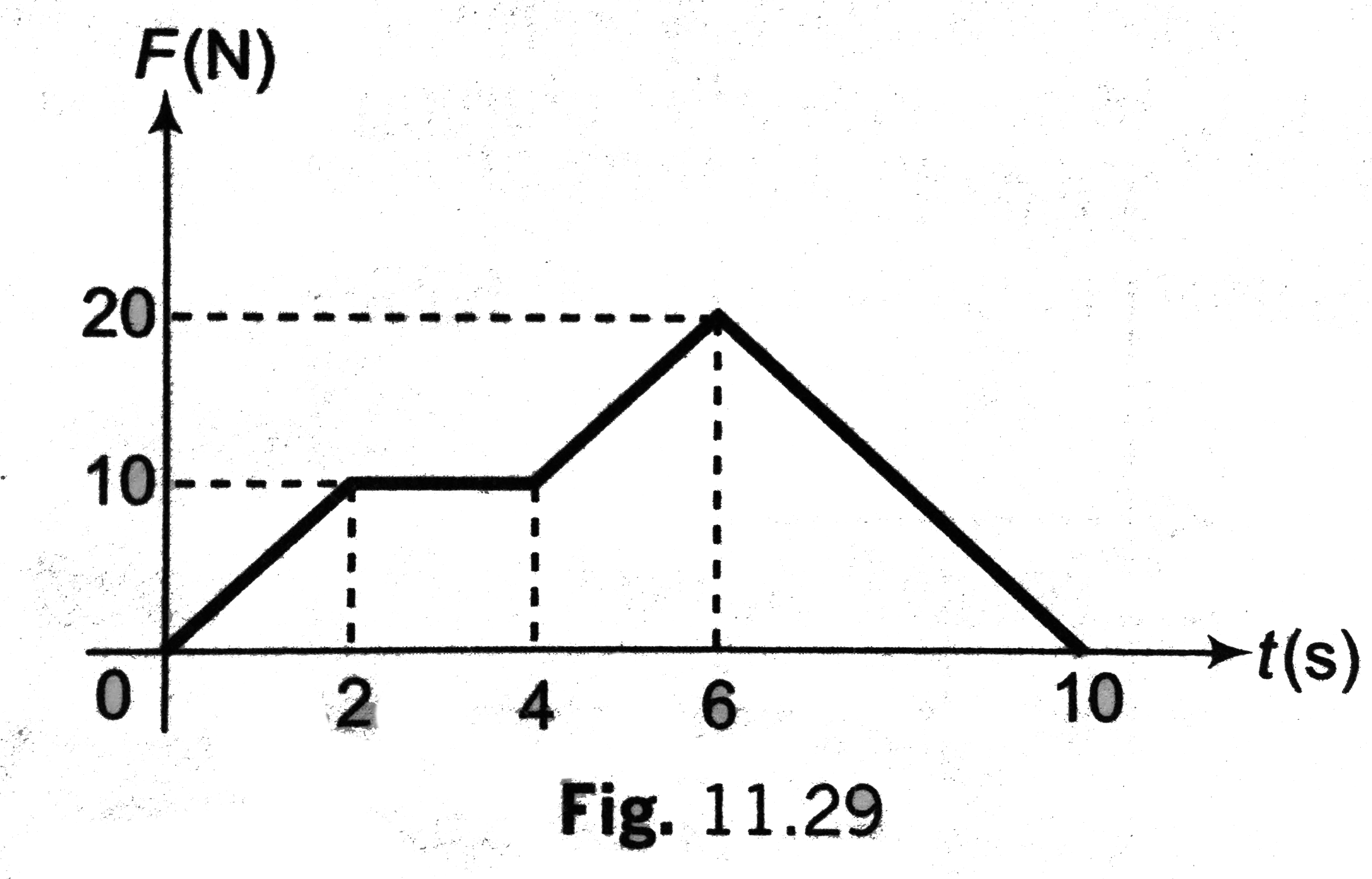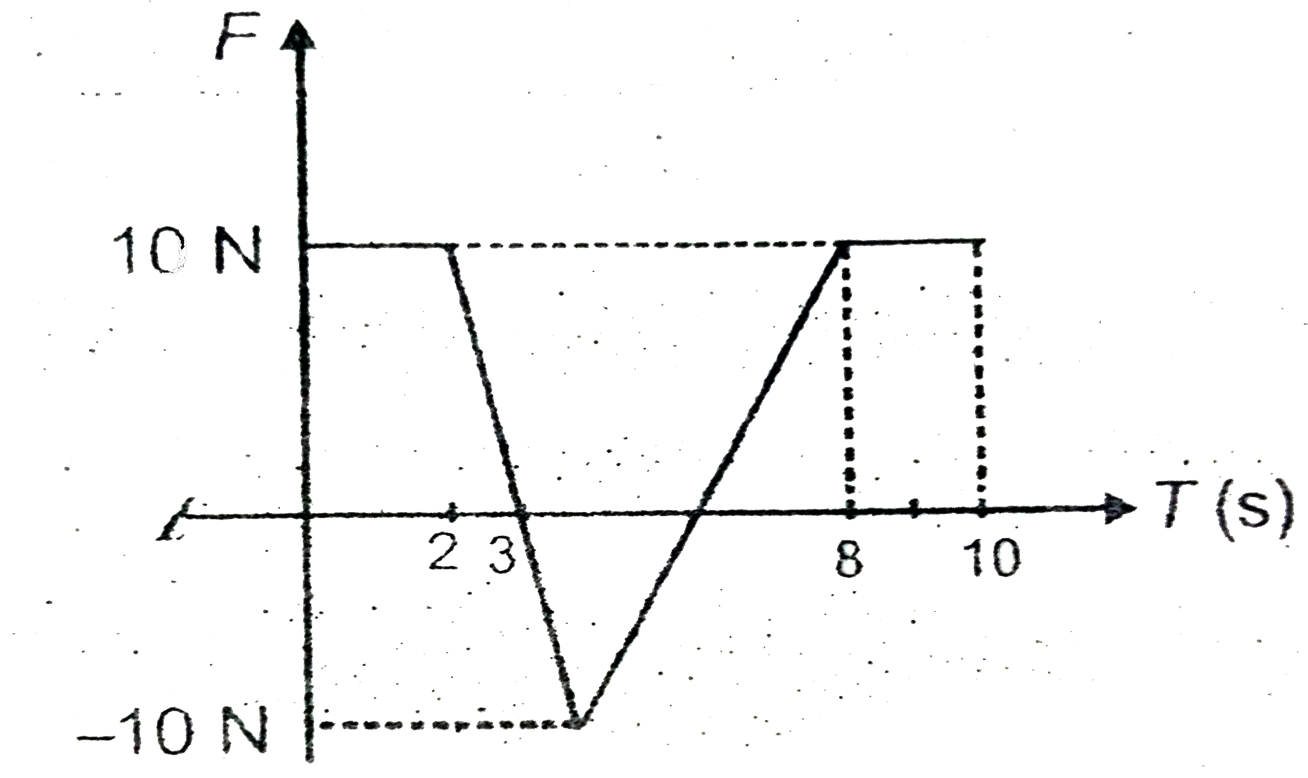The force on a particle of mass 10 g is (→i10+→j5)N. If it starts from rest what would be its position at time t=5s?
To solve the problem step by step, we will follow these steps:
Step 1: Identify the given values
- Mass of the particle, m=10g=0.01kg
- Force acting on the particle, →F=(10^i+5^j)N
- Time, t=5s
Step 2: Calculate the acceleration in the x-direction
The force in the x-direction is given by Fx=10N.
Using Newton's second law, F=ma, we can find the acceleration in the x-direction:
ax=Fxm=10N0.01kg=1000m/s2
Step 3: Calculate the displacement in the x-direction
Since the particle starts from rest, the initial velocity in the x-direction ux=0.
Using the equation of motion for displacement:
sx=uxt+12axt2
Substituting the values:
sx=0+12⋅1000⋅(5)2=12⋅1000⋅25=12500m
Step 4: Calculate the acceleration in the y-direction
The force in the y-direction is given by Fy=5N.
Using Newton's second law again, we can find the acceleration in the y-direction:
ay=Fym=5N0.01kg=500m/s2
Step 5: Calculate the displacement in the y-direction
Again, since the particle starts from rest, the initial velocity in the y-direction uy=0.
Using the equation of motion for displacement:
sy=uyt+12ayt2
Substituting the values:
sy=0+12⋅500⋅(5)2=12⋅500⋅25=6250m
Step 6: Combine the displacements to find the position vector
The position vector →r at time t=5s is given by:
→r=sx^i+sy^j=12500^i+6250^jm
Final Answer
The position of the particle at t=5s is:
→r=12500^i+6250^jm
---
- Mass of the particle, m=10g=0.01kg
- Force acting on the particle, →F=(10^i+5^j)N
- Time, t=5s
The force in the x-direction is given by Fx=10N.
ax=Fxm=10N0.01kg=1000m/s2
Since the particle starts from rest, the initial velocity in the x-direction ux=0.
sx=uxt+12axt2
Substituting the values:
sx=0+12⋅1000⋅(5)2=12⋅1000⋅25=12500m
The force in the y-direction is given by Fy=5N.
ay=Fym=5N0.01kg=500m/s2
Again, since the particle starts from rest, the initial velocity in the y-direction uy=0.
sy=uyt+12ayt2
Substituting the values:
sy=0+12⋅500⋅(5)2=12⋅500⋅25=6250m
The position vector →r at time t=5s is given by:
→r=sx^i+sy^j=12500^i+6250^jm
The position of the particle at t=5s is:
→r=12500^i+6250^jm
Topper's Solved these Questions
- BOOK - HC VERMA ENGLISHCHAPTER - NEWTON'S LAWS OF MOTIONEXERCISE - Objective -114videos
NEWTON'S LAWS OF MOTION
- BOOK - HC VERMA ENGLISHCHAPTER - NEWTON'S LAWS OF MOTIONEXERCISE - Objective -29videos
NEWTON'S LAWS OF MOTION
- BOOK - HC VERMA ENGLISHCHAPTER - NEWTON'S LAWS OF MOTIONEXERCISE - Questions for short Answer17videos
NEWTON'S LAWS OF MOTION
- BOOK - HC VERMA ENGLISHCHAPTER - LAWS OF THERMODYNAMICSEXERCISE - All Questions64videos
LAWS OF THERMODYNAMICS
- BOOK - HC VERMA ENGLISHCHAPTER - PHYSICS AND MATHEMATICSEXERCISE - Question for short Answer14videos
PHYSICS AND MATHEMATICS
Similar Questions
Knowledge Check
- Question 1 - Select One
The force on a particle of mass 10g is (ˆi10+ˆj5)N If it starts from rest what would be its position at time t=5s ?
A12500ˆi+6250ˆjmB6250ˆi+12500ˆjmC12500ˆi+12500ˆjmD6250ˆi+6250ˆjm
A body of mass 0.40 kg moving initially with a constant speed of 10m/s to the north is subjected to a constant force of 8.0 N directed towards the south for 30 s Take the instant the force is applied to be t = 0, and the position of the particle at that time to be x = 0, predict its position at t=−5s,25s,100s ?
View SolutionDisplacement of a particle of mass 2 kg varies with time as s=(2t2−2t+10)m. Find total work done on the particle in a time interval from t=0 to t=2s.
View SolutionA particle of mass 2kg is initially at rest. A force starts acting on it in one direction whose magnitude changes with time. The force time graph is shown in figure. Find the velocity of the particle at the end of 10s.
 View Solution
View SolutionA particie of mass 10 kg is driven by a machine that delivers a constant power of 20 watts. If particle starts from rest and moves along a straight line, then force (in Newton) on particle at time t(t> 0) is
View SolutionA particle of mass m is driven by a machine that delivers a constant power k watts. If the particle starts from rest the force on the particle at time t is
View SolutionA time varying force acts on a particle of mass 5 kg as shown in figure . Find the speed of the particle, in m/s , after 10 s , if particle was intially at rest .
 View Solution
View SolutionA force of 50 N acts on a body of mass 10 kg at rest. Its velocity after 5 seconds if the same force acts, is
View Solution
